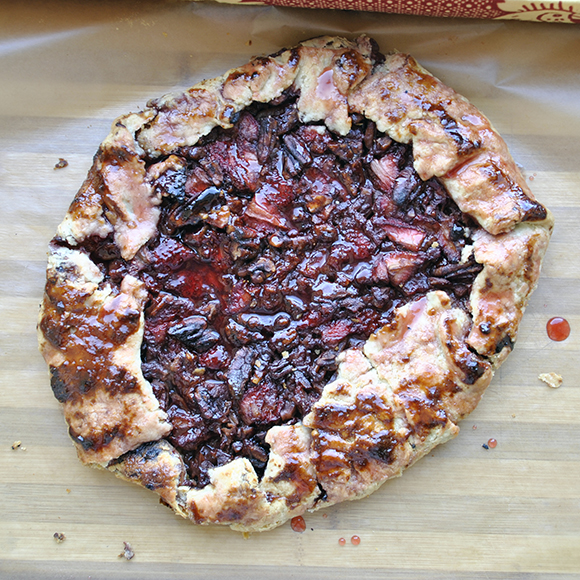
“Come with an open mind.” It was one of the few requirements Best Food Facts requested when they emailed an invitation to take part of their Taste 15 program: Unearthing the Art and Science of Food. I approach their program with skepticism. Their sponsor is The Center for Food Integrity, and their membership include brands and organizations to support and boycott. Here’s the disclosure: My recent trip to Sacramento, California and two additional trips in the future including all expenses are sponsored by Best Food Facts, and all opinions in this series are my own. Follow the hashtag #Taste15 to read about other food bloggers and farmers participating in the same program.
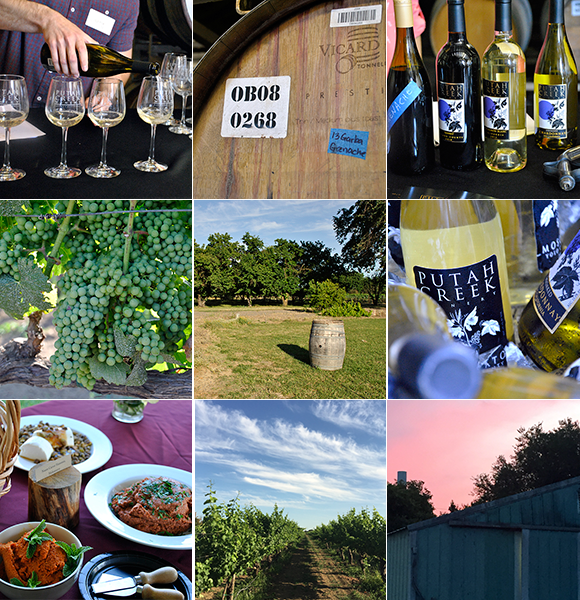
We think we have open-minds, but when core beliefs are challenged — especially with facts — we continue to fiercely resist. Before flying to Sacramento, I read “A Plea for Culinary Modernism” by Rachel Laudan. The article was a mental palate cleanser.
Besides arriving in Sacramento with an open-mind, Best Food Facts requested a story about an “ah-ha” experience along with a recipe. And, there were several. I gasped when a farmer and a scientist (who don’t know each other, in separate events) mentioned seedless watermelons isn’t a GMO product. The seedless watermelons are females as the male watermelons have seeds (learn more on Best Food Facts’ “Food For Thought blog” here). There was the humbling experience of re-learning the importance of pasteurize dairy (Lesson of the day: Don’t take a chance on raw milk. Get the facts here). Another ‘ah-ah moment that makes sense,’ was learning about honey being impossible to certify as organic. Can anyone tell a bee which field to pollinate as they travel an average of five miles from their hives?
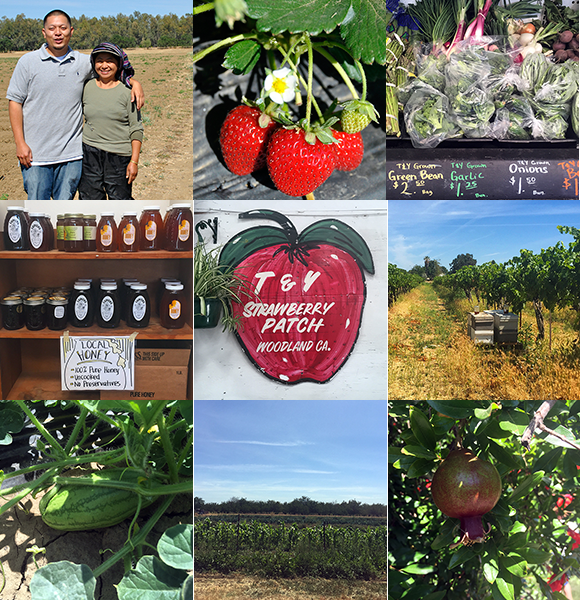
The Challenge
The big moment that challenged my opinion were brief conversations about biotechnology (commonly known as biotech) companies, in which Monsanto is the most well-known. In an unusual perspective, as our bus pasted a Monsanto office on the way to T&Y Strawberry Patch, most of the farmers in our group swooned with amazement as the hairs on my neck stood tall. “Keep an open mind… an open mind… It’s okay for people to have different opinions,” I silently tell myself as a question crossed my mind: What is it about biotech that makes this group of people—who use their products everyday—happy? Wait, have I researched the official definition of biotech and GMOs?
According to BestFoodFacts.org, the definition of biotech is…
“…the use of a living organism to perform a task or function.” Historically, the term was used to describe processes like cheese, yogurt, wine or beer production. In modern terms, however, biotechnology is commonly used to refer to the newer methods of genetic engineering of organisms.
“VIDEO: What are Genetically Modified Foods? A Basic Explanation of a Hefty Topic.” BestFoodFacts.org. Nov. 6, 2012.
…And, the definition of GMO:
“The term GMO, or genetically modified organism, refers to “a plant or animal altered using modern techniques of genetic modification,” commonly termed genetic engineering. Since crops have been genetically modified by classical methods for centuries, a more accurate term for the foods and crops created with the technologies used today might be GE or genetically engineered.”
“VIDEO: What are Genetically Modified Foods? A Basic Explanation of a Hefty Topic.” BestFoodFacts.org. Nov. 6, 2012.
As the farmers in our group basked in their happiness about seeing Monsanto and my nerves returned to being calm, I initially decided to be still and listen to their reasons. After all, my social circle of friends and colleagues detest Monstanto. But, what could I say in their presence and to scientists (on separate occasions) who spoke to our group? It’s intimidating, but asking questions was encouraged. With an open mind, I learned about the possibilities of GMO seeds, especially since the planet’s climate is changing as the human population is growing. If the future is based on such trends, then the chances of food shortages is a real problem.
Am I a cheerleader for biotech? Not quite. My reasons are political: to allow a few corporations to be responsible for the world’s food supply could be a dangerous idea. Environmentalists are concerned about monoculture crops. It’s when one type of crop grows every year and over time depletes the soil of nutrients, causing farmers to use more chemical fertilizers (learn more here). Those same chemical fertilizers have the Environmental Protection Agency (EPA) concerned about fertilizers (both chemical and organic) running into waterways. In addition, the idea of farmers being indebted to few corporations to repurchase seeds every year doesn’t seem like a wise financial decision, especially for farmers in developing countries.
“…Controlling the seeds is not some abstraction. Whoever provides the world’s seeds controls the world’s food supply.”
“Monsanto’s Harvest of Fear,” Vanity Fair. By Donald L. Barlett and James B. Steele.
Political reasons aside, biotech companies are changing global agriculture. For every negative story about biotechs, there are positive stories to share (this is a difficult admission). One such is Golden Rice, which is basic white rice genetically modified to be enriched with vitamin A. It’s being sold by a nonprofit organization. According to NPR.org, one bowl of golden rice supplies 60 percent of a child’s daily requirement of vitamin A, a necessary nutrient important for early childhood development and the prevention of blindness.1
And, if bananas are an essential source of potassium, currently there is a disease, Fusarium Oxysporum Tropical Race Four, swiftly destroying global crops. It’s only a matter of time, before it reaches Latin American countries, which supply 82 percent of the world’s demand for bananas. The irony of banana’s potential demise, is that it’s a monocultural crop. The world eats the Cavendish variety. There are 1,000 other varieties of bananas, but they’re fragile and don’t produce enough fruit to meet global demand–this is where GMOs could help. According to Dan Koppel, author of 2008’s “Banana: The Fate of the Fruit that Changed the World,” bananas need a mix of diversification and GMOs if they’re going to have a future.2
The goal of most farmers is to protect their crops from disease and insects. Without the use of pesticides, overall food production decreases, causing prices to soar. Farmers have various strategies to fight insects, and insecticides are the last resort.3 And, while we’re discussing the safety of chemical versus organic pesticides, let’s not underestimate the toxicity of organic pesticides. In theory, organic pesticides are supposed to easily break down in the environment.4 The issue of toxicity levels of pesticides is complex. For starters, BestFoodFacts.org offers alternative facts that aren’t commonly discussed when debating the use of pesticides. With an open mind I’m learning that the issue of biotech and its role in our food supply needs to be further debated among food writers, nutritionists, other food-related professionals, scientists and governmental policy makers.
“We’re arguing over how evil Monsanto is, rather than asking how government can effectively regulate a system in which corporate, agricultural, consumer and environmental goals are often at odds.”
“The last thing Africa needs to be debating is GMOs,” The Washington Post. By Tamar Haspel.
No Turning Back
Let’s return to the earlier reference of Rachel Laudan’s “A Plea for Culinary Modernism.” We fear new technology. Especially if it drastically changes our lives. When the train was invented in the 1800s, farmers feared trains would cause cows to produce stale milk. Instead, the train enabled fresher milk to be more quickly delivered than by horse and carriage.5 Sometimes being apprehensive about new technology is justified and at other times, it’s not. With the internet, opinions are expressed as facts, facts from experts are dismissed and scientists are rarely used as a resource. The person who writes the loudest is the most believed. Few people are critically-thinking about opinions. Daily news articles are written with subtle opinions, when the writer is suppose to state facts — from both sides — of a situation. Further marginalizing our belief systems, is our tendency to read articles or opinions by writers solely representing our beliefs. One dairy farmer, who has seen how technology changed his livelihood spanning at least six decades proclaims his appreciation of how technology makes farming easier today. He doesn’t want to go back in time.
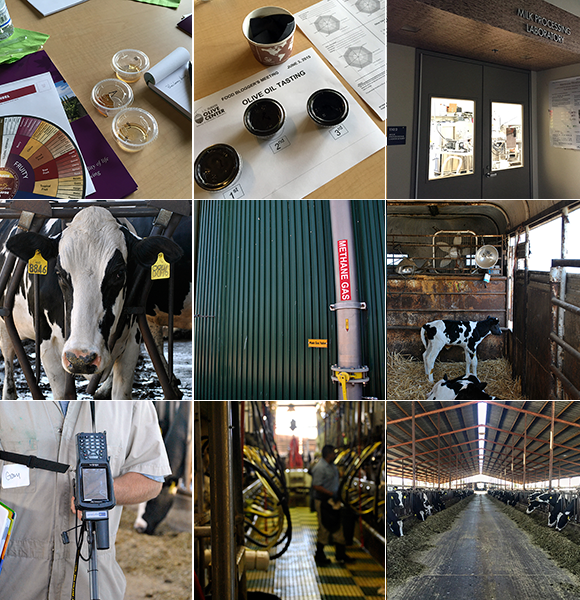
When talking with dairy farmers among our Taste 15 group, I found that they were sensitive and resented the misinformation about their livelihood, and they repeatedly told stories about the love for their cows and farms. It’s a difficult job that starts at 3:30 in the morning. I don’t doubt the journalists who wrote about witnessing irresponsible dairy farmers, but is it possible a few bad dairy farmers happened to negatively impact the opinions about the overall industry? Should we honestly start asking ourselves, “How much do we know about dairy farms?” While in Sacramento, I visited my first dairy farm. That experience gave me more “ah-ha” moments. Such as learning about corn being a grass. Are dairy products labeled “grass-fed cows” worth the extra expense? We were encouraged to ask about the use of hormones in dairy (learn more here), the production of methane gases and so on.
About the Recipe for Strawberry Pecan Galette
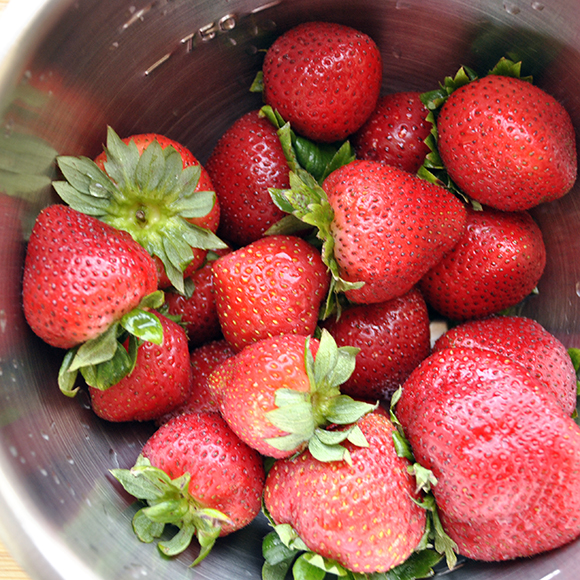
The morning of the second day of the Taste 15 tour started with a ride about an hour outside of Sacramento to visit T&Y Strawberry Patch. I grew up in a neighborhood surrounded by strawberry fields, so the experience was nostalgic and fun. Besides learning about the difference between seedless and seeded watermelons, the farm inspired a recipe for a Strawberry Pecan Galette, which was made when I returned to Brooklyn. It’s a simple, berry delicious recipe, in which strawberries roast on top of a buttery crust as T&Y Strawberry Patch’s fresh pecans provide a nutty crunch.
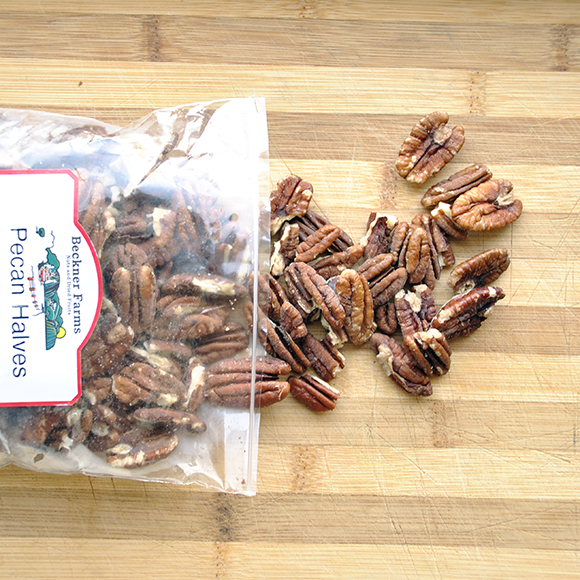
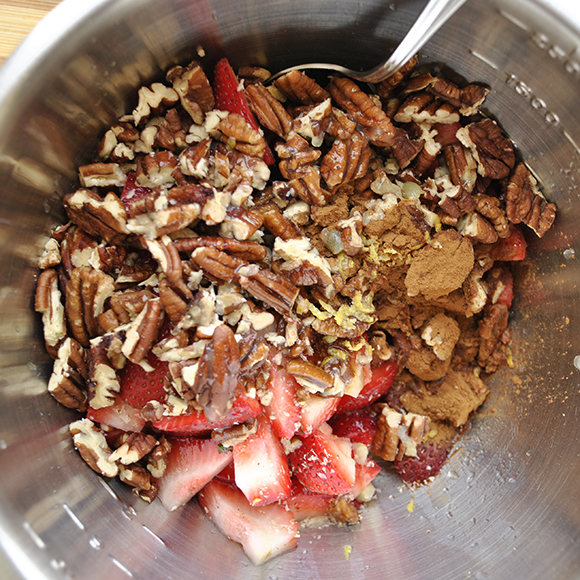
There’s More to Come
Sacramento, California was the first trip out of three tours that are part of Taste 15: Unearthing the Art and Science of Food program. This trip was full of “ah-ha” moments, in which experiencing facts about growing food in three days was just as enriching as my life knowledge from my love of cooking, reading about food and developing recipes. But, what was the most impactful “ah-ha” moment of the trip? It’s how we’re debating biotech’s role in agriculture. Current debates are marginalizing and not addressing problems. Perhaps, it’s the fear of an open mind.
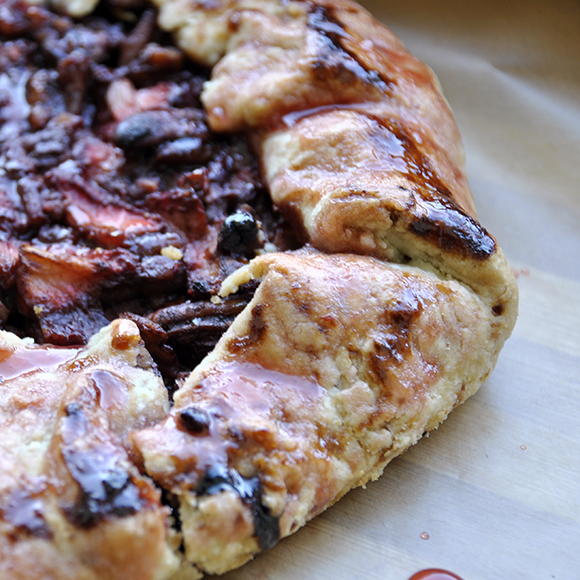
Ingredients
- 16 oz. fresh strawberries; green top discarded and quartered
- A pinch of sea salt
- 1 tbsp. coconut sugar; more or less depending on the sweetness of the strawberries
- 1 cup whole, raw pecans; roughly chopped
- 2 tsp. ground cinnamon
- 1/8 tsp. ground cloves
- 1/8 tsp. ground ginger
- 1/8 tsp. fresh grated nutmeg (or ground)
- 1/2 tsp. lemon zest
- The juice of half a lemon
- 2 tsp. olive oil or melted, cool butter
- 1 tsp. vanilla extract
- 1/2 cup strawberry jam
- 2 tbsp. water
- 1 recipe for Flaky Pie Crust Dough (Recipe Here)
Directions
- Pre-heat oven to 425°F. Line an ungreased baking sheet with wax paper.
- Make the filling: Light toss strawberries, salt, sugar, pecans, cinnamon, cloves, ginger nutmeg, lemon zest, olive oil and vanilla in a medium bowl. Set aside to allow the juices to concentrate at the bottom of the bowl.
- Make the strawberry jam glaze: Place strawberry jam in a fine-mesh strainer over a small saucepan. Using a metal spoon, push jam thru the strainer until only the seeds are left. Discard seeds. Stir in two tablespoons of water. Warm glaze over medium heat until it starts to simmer. Place saucepan aside.
- Follow the directions here for making the flaky pie crush dough.
- Roll flaky pie crust dough over the baking sheet lined with wax paper.
- Using a slotted spoon (Use the juice for another recipe or add it to water for a flavorful drink), place strawberry and pecan filling over the center of the dough. Gently spread filling at about two inches away from the dough’s edge.
- Gently fold the dough’s edges over the filling. Don’t completely cover the filling. Gently and lightly brush pastry with half the strawberry jam glaze.
- Place galette in the oven to bake for 30 to 45 minutes or until the dough is golden brown.
- Let Strawberry Pecan Galette cool for about eight minutes. Brush pastry part with strawberry jam glaze. Using a spoon, drizzle leftover strawberry glaze over the filling.
- Continue to let the galette cool to allow the filling to slightly solidify for at least 30 minutes.
- Be greedy and enjoy.
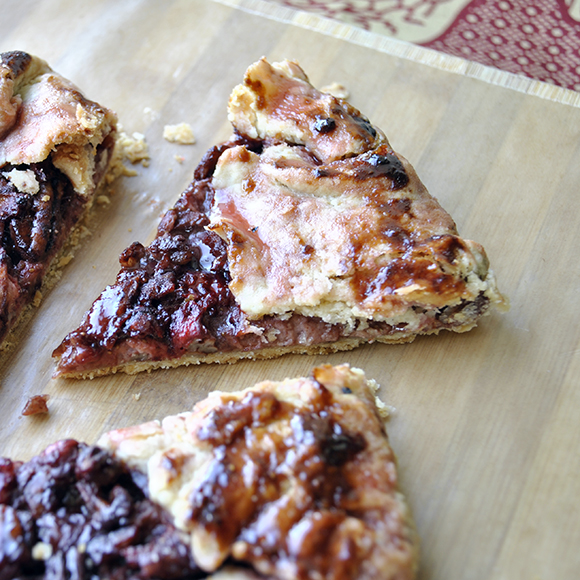
Want to Learn More About Biotech?
The Pro Side
“Wisconsin’s [Concentrated Animal Feeding Operations] (CAFOs) are among the most regulated in the nation. All CAFOs are subject to permits that require them to have zero discharge, which means they aren’t allowed to discharge any phosphorus from their production sites to surface or ground water. The nutrient management plans that CAFOs must prepare are designed to manage nutrients by maximizing their benefit as an organic fertilizer, while minimizing their impact on water resources.”
“Another View, Runoff Pollution: Don’t blame large farms for pollution,” Milwaukee-Wisconsin Journal Sentinel. By John Holevoet. September 24, 2014.
“Let’s start with the facts. Humans have been genetically modifying food and feed plants and animals for millenniums, until recently only by repeatedly crossing existing ones with relatives that have more desirable characteristics.”
“Fears, Not Facts, Support G.M.O.-Free Food,” New York Times. By Jane E. Brody. June 8, 2015.
“Agronomists have been working on these problems for years, but the rapid population growth of humans makes overcoming these challenges increasingly urgent. If we can’t feed the world, it will eventually feed on us.”
“GMO Scientists Could Save the World From Hunger, If We Let Them,” Newsweek. By Tom Parrett. May 21, 2015.
“There’s a kind of rice growing in some test plots in the Philippines that’s unlike any rice ever seen before. It’s yellow. Its backers call it “golden rice.” It’s been genetically modified so that it contains beta-carotene, the source of vitamin A.”
“In A Grain Of Golden Rice, A World Of Controversy Over GMO Foods,” NPR.og. By Dan Charles. March 7, 2013.
“The assumption, of course, is that these natural pesticides are safer than the synthetic ones. Many of them are, but there are some notable exceptions. Rotenone, a pesticide allowed in organic farming, is far more toxic by weight than many synthetic pesticides.”
“Organic Shmorganic,” Slate.com. By Melinda Wenner Moyr. January 28, 2014.
“Glyphosate has been in use for some 30 years, during which yields have increased about one percent per year. Such sustained yield increases would not be possible if glyphosate was poisoning the soil. If the charge was true, one would see a barren wasteland when driving through the Midwest, rather than the fertile fields of corn and soybean that grow there today.”
“What’s All the Buzz about Glyphosate? ”BestFoodFacts.org. Oct. 28, 2014.
“Without the use of crop protection products, overall food production would decline, and many of the fruits and vegetables we enjoy in the store would be in short supply. Because crop protection products can help improve crop yields and supply, this help keeps our food at a stable price in the grocery store. Crop protection products don’t only affect food crops though; production of certain fibers and oils would also be affected, as crops like cotton are highly susceptible to pests and disease…”
“Why Do Farmers Spray Chemicals on Crops?” The Food Journal and Food, Nutrition & Science. March 12, 2015.
“The only real solution (as Dan Koppel, author of 2008’s Banana: The Fate of the Fruit that Changed the World, has argued) is probably a mixture of diversification and GMOs.”
“Why We Need GMOs to Fight Off the Banana Apocalypse,” Magazine.Good.Is By Mark Hay. July 10, 2015.
“GM crops might be more reliable than what Ugandans currently plant, especially in lean years…”
“Will GMOs Help Protect Ugandan Families Against Hunger?” NPR.org. By Michaeleen Doucleff. June 25, 2013.
The Con Side
“The biotech industry is taking us into a more pesticide-dependent agriculture when they’ve always promised, and we need to be going in, the opposite direction…”
“Farmers Cope With Roundup-Resistant Weeds,” The New York Times. By William Neuman and Andrew Pollack. May 3, 2010.
“Nitrogen and phosphorus are the most common agricultural pollutants found in public waters in the Mississippi River Basin. These chemicals contribute to the growth of harmful algae, fish kills, animal deaths, and the classification of some drinking water sources as unsafe for the public.”
“How Agriculture Affects the Mississippi River,” Mississippi River Collaborative at MSRiverCollab.org.
The Institute for Responsible Technology (IRT) discusses the cons of GMOs. Learn more at ResponsibleTechnology.org
“For me, the idea of owning intellectual-property rights for seeds is a bad, pathetic attempt at seed dictatorship…”
Seeds of Doubt, The New Yorker. By Michael Spector. August 25, 2014
“…An 11-year-old would have to eat 15 pounds of cooked golden rice a day—quite a bowlful—to satisfy his minimum daily requirement of vitamin A. Even if that were possible (or if scientists boosted beta-carotene levels), it probably wouldn’t do a malnourished child much good, since the body can only convert beta-carotene into vitamin A when fat and protein are present in the diet. Fat and protein in the diet are, of course, precisely what a malnourished child lacks.”
“The Way We Live Now: The Great Yellow Hype,” Originally appeared The New York Times Magazine. By Michael Pollan. March 4, 2001.
“But we know that some of these chemicals that we’re finding in the runoff from the ag fields can affect [aquatic] reproduction and egg production. Whether they are at the concentrations that can do that or not — we don’t know yet.” USGS Biologist Diana Papoulias.
“What Is Farm Runoff Doing To The Water? Scientists Wade In,” NPR.org’s The Salt. By Abbie Fentress Swanson. July 5, 2013.
Balanced viewpoints to completely explain GMOs and to learn about the science of food.
Learn more about the science of food at BestFoodFacts.org.
“The vast majority of GMO crops do one of two things. They either create herbicide resistance, allowing farmers to chemically kill weeds but not damage their crops, or they cause plants to produce a toxin that kills some insects (a “built-in” insect resistance). There are environmental and human health benefits (and drawbacks) to both of these technologies.”
“GMOs: Are They Safe? What Are The Pros and Cons?” EatingWell Magazine. By Barry Estabrook. July/August 2015.

Final Word
The goal of this story is to write about an “ah-ha” moment, and it was a complicated experience. I could’ve wrote an easy story about seedless watermelons or bees, but I participated in the Taste 15 program to “open my mind” to new ideas. Writing about biotech was inspiring, because my beliefs were challenged by new information. The story’s objective isn’t about solving problems, but to encourage visitors to think about how biotech is being debated. It is also my hope that this story inspires visitors to continue to read additional—hopefully, unbiased—news discussing the pros and cons of biotech to develop their own opinions.
Footnotes:
1 “In A Grain Of Golden Rice, A World Of Controversy Over GMO Foods,” NPR.og. By Dan Charles. March 7, 2013.
2 “Why We Need GMOs to Fight Off the Banana Apocalypse,” Magazine.Good.Is By Mark Hay. July 10, 2015.
3 “Why Do Farmers Spray Chemicals on Crops?” The Food Journal and Food, Nutrition & Science. March 12, 2015.
4 “Organic Shmorganic,” Slate.com. By Melinda Wenner Moyr. January 28, 2014.
5 “Trains 1830 To 1900,” The History Learning Site. By C N Trueman.
Sanura, let me just say that you were really brave to take this on :)! That aside, I was skeptical ahead of your trip and to be very honest, I am still so.
I understand the power politics at play in the great food debate and as the daughter of a farmer, wife of a chef, food columnist, broadcaster, blogger, mother and former MarComms exec, I have a very triangulated perspective of the discussion.
I believe there is a role for technology in agriculture, as in every other area of life… technology is simply a tool with which we use to make our lives easier.
But sometimes even good things become harmful.
SO yes there is a place for technology and research into food and yes there is a place for facts and not myths. But too much technology can spoil nature.
There has to be a balance and right now due to power and politics, the one with the deepest pockets has the most brawn. We are entitled to having different opinions about our food and demanding better choices in the marketplace. And while our pockets may not be deep, every time we spend, we make a choice about whose pockets we fatten.
Much Love,
K
Well, I had an ah-ha moment, just reading your post! My family and I were talking about watermelons yesterday. My father was saying that they don’t taste as sweet as they used to when he was a kid. My mom and I were saying that it must be all the GMOs and that’s why there are seedless watermelons now. Even though they really do have seeds. Now you have informed me! I’ll have to tell my mom about the seeded vs seedless, being a gender issue. Who knew!!??
Hi, Roxi! You’re welcome! It’s quite an experience. Thank you so much to you and BestFoodFacts.org for organizing the tour. Looking forward to seeing everyone in Arkansas for the next trip. -Sanura
Hi, Bethany! You’re welcome and thank you for the learning experience. -sw
Thank you, Jennie!
Sanura, you’re incredible. Few people can truly open up and immerse themselves into an experience – wow! Thanks for providing such a deep dive into the intricacies of your ah-ha’s and your internal dialogue, as well as adding new information into the mix! I am in the process of reading the information you linked out to – really appreciate the pros/cons approach that include broader topics about farming.
Thank you for this thoughtful post and for keeping the conversation going! – Bethany
Thank you for joining the experience, Sanura! Loved reading about your perspective – and the awesome recipe!
Excellent post! I learned a lot.